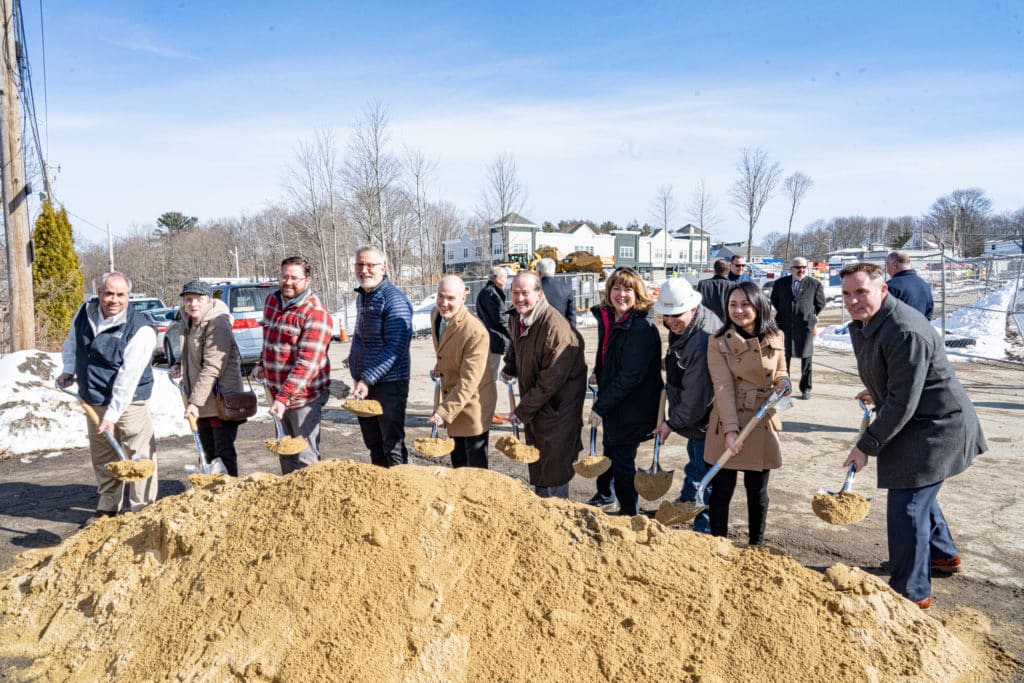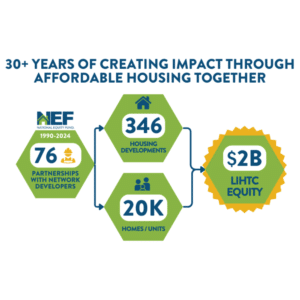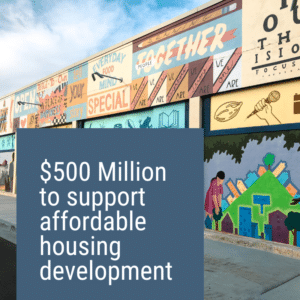The right partnership can make all the difference. NeighborWorks Housing Solutions was born out of the merger of NeighborWorks Southern Mass. and Housing Solutions for Southeastern Massachusetts.
Before the 2019 merger, the two organizations served a total of around 11,000 households. By 2021, the new organization served more than 20,000.
They’ve been able to expand their capacity into new communities, reaching households across three large counties in southern Massachusetts. They have developed nearly 900 units of affordable housing and have more than 400 in the pipeline.

“The sky’s the limit on our growth and partnerships, because the need is so great in so much of the region,” said Robert Corley, CEO of NeighborWorks Housing Solutions.
The merger started with an introduction through a NeighborWorks America expansion grant helping the then-NeighborWorks Southern Mass. take its services into New Bedford. They brought in a partner to share office space – Housing Solutions.
“Early on a strategic partnership between the agencies made more and more sense with how compatible we were. The idea between the existing directors and the boards was that we could do more and leverage more resources into the region working together,” Corley said.
Discussions of a merger started in 2018; it was finalized in late July 2019.
“It definitely wasn’t an easy process; it took time, but both Boards were committed to the goal. As a result of their commitment and leadership it has been very successful. We also had an amazing consultant named Carl Sussman who was instrumental in our planning. We are a much stronger organization because of this careful planning and work,” Corley said. “Our region has a stronger voice and has better access to resources as a result, in that we are bringing much more capacity – getting deeper and wider into the area and offering our services throughout. We have continued to attract additional funding, contracts, resources, and talented staff. It’s been a great success.”
Boards that worked well together and had trust were a key to merger success, along with buy-in from both organizations’ partners. They also fundraised to help make it easier to move forward.
“None of this merger success or our growth would be possible without our talented and dedicated staff and our volunteer Board of Directors. That combined with the local, state, and federal partnerships we have is the key to our ongoing success,” Corley said.
Their merger was finalized just a few months before the COVID-19 pandemic hit, a time when many groups found themselves facing a crisis. For the new organization, this applied even more pressure. In a moment that could’ve exposed cracks, NHS came together.
“The pandemic helped the staff culture aspect of our merger. Suddenly the physical separation of all our different offices and departments were removed as we all went virtual. In a crisis, you come together. Everything got accelerated, and it kept things moving,” Corley said.
Rental Assistance and the Cliff Effect
One of the pivots they made early on was rental assistance, becoming the third-largest provider in the state with up to 1,000 phone calls a day.
“It’s been a challenging couple of years, we have been focused on assisting so many households in crisis who desperately need assistance. But we’ve also been able to help so many more households because of our post-merger capacity,” Corley said.
They currently see about 500 applications, about $2 million in rental assistance, weekly. They are now preparing for what’s ahead.
“There was a housing and eviction crisis in Massachusetts before the pandemic. Much of it was bridged for one year, then another. The need after all the temporary federal and state crisis support funding is gone will be great. We’re very concerned about the ‘cliff effect’ and are working on what’s next for so many of these households,” Corley said.
This includes creating a subsidy for the thousands of families temporarily supported through the state funding program, so that they don’t have to lose their housing.
“We are always trying to build our way out of the affordable housing crisis but there is an enormous level of need, and this can’t be the only answer. Everything must be on the table, including more permanent rent subsidies to support working families receiving federal pandemic support that will be evicted from the apartment when it times out,” Corley said.
Improving Accessibility and Services
The pandemic also highlighted an opportunity to offer accessible electronic and remote services to families. NHS is incorporating a hybrid model, focused on local in-person sessions as well as remote ones.
“Technology is a great tool to provide access to our services for so many more, but it can never be a barrier for the many who do not have it,” Corley said.
Expanding their services includes community relations and asset management to focus on localized work with residents. They are also working to build on their policy work and ability to affect change around zoning and funding in their service area, to be a voice for the region in places of power.
Programs and services that will combine to help the economic advancement of their families are an important piece of their future plans. This includes how to best measure success, especially when it comes to homeownership. When one family becomes a homeowner, the impact resonates. It also frees up a subsidy for other families who may be at a different point in their own cycle.
“It’s not always the big numbers that matter, everyone has a part,” said Serenity Belo, NHS Resource Development Director.
Partnerships for the Future
The next three to five years provide a tremendous opportunity for NHS to build a robust development department that engages with current and prospective donors, partners, and volunteers to bring them closer to their mission and help tell their story, Belo said.
“We are helping our supporters and partners see the impact of our work and how important they are to help advance the economic mobility of people in our communities. People really want to support that,” Belo said.
This requires partnership across the board – other CDCs, housing agencies, homeless service providers, and more.
“NeighborWorks America has helped instill our ability to partner and work well with other groups. Being one of the larger nonprofits in Massachusetts, that’s something we’re very much trying to continue. Though we provide many services, we continue to grow; collaboration and partnerships with many organizations matter and have a positive impact on the people we serve.”











